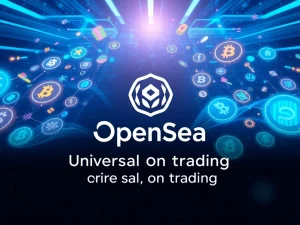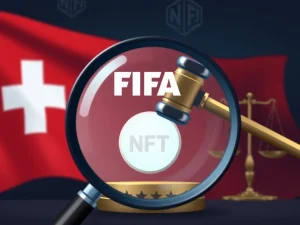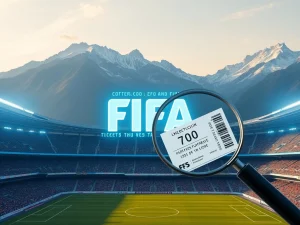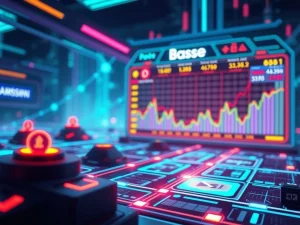Explosive NFT Market Boom: 94% Surge to $6.6B in July Driven by Blue-Chip Sales & CryptoPunk Triumph
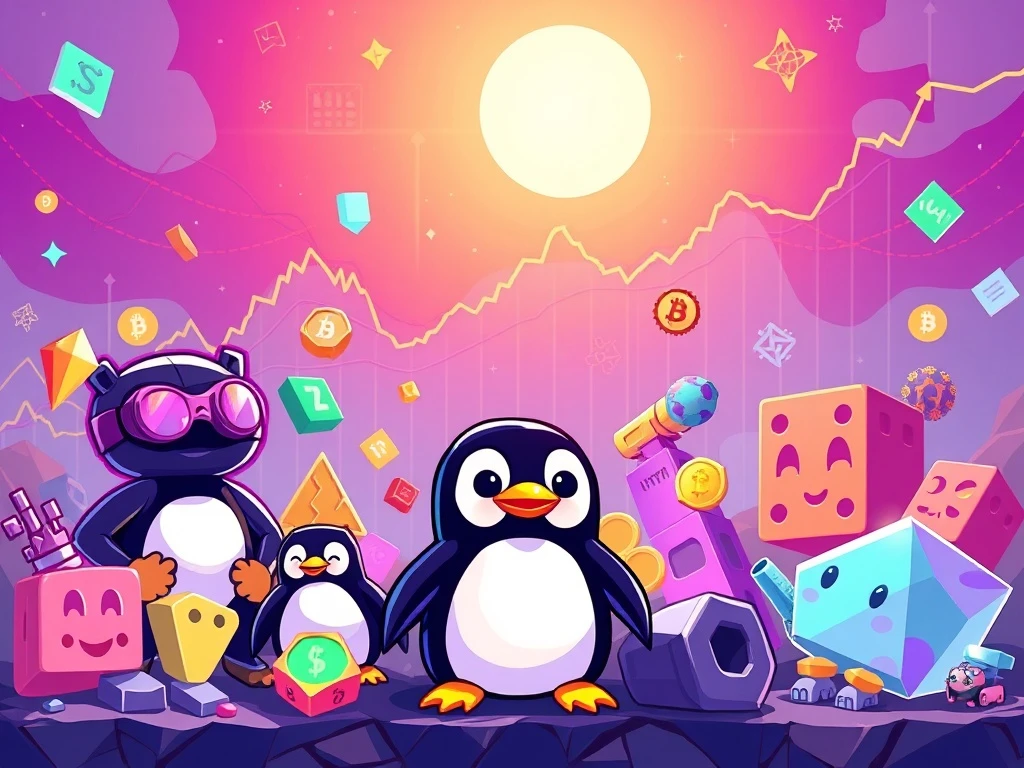
For those closely watching the world of digital collectibles, July 2025 delivered a truly spectacular turnaround. After a challenging period, the NFT market didn’t just recover; it exploded, demonstrating a remarkable resurgence that has caught the attention of investors and enthusiasts alike. This dramatic shift signals a potential new chapter for non-fungible tokens, moving beyond speculative frenzy towards more sustainable growth driven by established assets and innovative platforms.
The Remarkable Resurgence of the NFT Market in July 2025
The numbers speak for themselves. In July 2025, the total market capitalization for NFTs soared by an astonishing 94%, reaching a robust $6.6 billion. Weekly trading volumes mirrored this enthusiasm, spiking by 51% to hit $136 million [1]. These figures represent the highest levels seen since early 2025, effectively reversing a trend of consecutive quarterly declines that had left many wondering about the future of digital assets. This significant upturn suggests renewed confidence and interest, marking a pivotal moment for the sector.
Blue-Chip NFTs Lead the Charge: High-Value Assets Take Center Stage
The driving force behind this impressive comeback was undeniably the performance of blue-chip NFTs. These established collections, known for their historical significance and perceived long-term value, saw average prices jump by 40% in just seven days, reaching $146 [1]. While overall sales increased modestly by 7%, this indicates a clear shift in market dynamics: fewer, but higher-value, transactions are now dictating growth, emphasizing quality over sheer volume. This trend aligns with a maturation of the market, where investors are increasingly seeking stability and proven worth.
CryptoPunks and Pudgy Penguins: Defining the Revival
- CryptoPunks, one of the earliest and most iconic NFT collections, emerged as a standout performer. Their floor prices surged by an impressive 53%, crowned by a single CryptoPunk selling for a staggering $5 million [1]. This monumental sale reaffirmed their elite status as Web3’s premier digital collectibles, solidifying their position as a cornerstone of the blue-chip segment.
- Another collection making significant waves was Pudgy Penguins. This charming collection not only gained substantial traction but also surpassed the Bored Ape Yacht Club in market capitalization. Their floor prices have seen an incredible 539% surge since their initial mint [1]. What sets Pudgy Penguins apart is their strategic expansion into physical merchandise, including plush toys. This innovative approach effectively bridges the gap between Web2 and Web3 experiences, enhancing real-world utility and broadening their appeal beyond digital screens.
- Other notable recoveries include Moonbirds, whose trading volume skyrocketed 600% after a key partnership and acquisition, and Art Blocks, which saw average sale prices jump 156% following new collector features and platform upgrades [1].
Profile picture (PFP) NFTs collectively dominated 37% of the total volume, signaling a renewed speculative demand for status-driven digital assets. This indicates that while the market is maturing, the desire for exclusive, recognizable digital identities remains a powerful motivator.
Regulatory Clarity and the TON Blockchain: Paving the Way for Growth
Beyond the impressive sales figures, crucial developments in regulatory clarity and blockchain innovation have played a pivotal role in reigniting interest in the NFT market.
The legal landscape for NFTs has become significantly clearer:
- The SEC’s confirmation that many NFTs, particularly those with royalty mechanisms, do not qualify as securities, has provided much-needed legal reassurance to creators and collectors alike [1]. This clarity reduces uncertainty and fosters a more confident environment for participation.
- Additionally, the Ninth Circuit Court of Appeals’ ruling affirmed NFTs as trademarkable goods under the Lanham Act, further legitimizing their role in commercial markets and paving the way for broader brand integration [1].
The Telegram Open Network (TON) blockchain also played a significant role in this revival. Its growing ecosystem has become a hotbed for NFT activity:
- Snoop Dogg’s NFT collection on TON saw an incredible $12 million worth of assets sold within just 30 minutes [1].
- The TON NFT market cap rapidly reached $200 million, with projects like Crystal Eagles and Statues of Liberty selling out rapidly, demonstrating the platform’s growing appeal and efficiency [1].
- Telegram founder Pavel Durov’s announcement of upcoming blockchain minting and secondary market features further fueled optimism, positioning TON as a major player in the NFT space [1].
Navigating Volatility: Is the NFT Market Truly Back?
While the July surge is undeniably exciting, it’s important to remember the broader market context. Q2 2025 saw trading volumes plummet by 80% year-over-year to $823 million, leading to the shutdown of multiple NFT platforms and a staggering 97% collapse in the NFT lending market [1]. This stark reminder of past volatility underscores the need for continued caution.
The current market shift toward high-value, blue-chip NFTs contrasts sharply with previous volume-driven activities. This trend aligns with historical patterns where PFPs and art categories often lead recoveries, with fewer trades at premium prices driving overall growth [1]. While sectors like sports, music, and fashion NFTs have struggled to gain momentum, gaming NFTs showed a slight cooldown after a strong Q2 performance.
The revival underscores a broader transformation in NFT dynamics. The combination of strong performance from blue-chip collections, increasing regulatory clarity, and significant innovation from platforms like TON blockchain has created a more robust foundation for sustained interest. However, the market remains inherently volatile. The ability of NFTs to deliver tangible real-world utility and maintain legal clarity will be paramount for long-term adoption and stability. As the NFT market re-emerges, it enters a new phase, demanding both excitement and prudent observation.
Frequently Asked Questions (FAQs)
Q1: What caused the significant surge in the NFT market in July 2025?
The surge was primarily driven by strong performance in blue-chip NFT collections, such as CryptoPunks and Pudgy Penguins, coupled with increased regulatory clarity regarding NFTs and significant activity on emerging platforms like the TON blockchain.
Q2: What are ‘blue-chip NFTs’ and why are they important?
Blue-chip NFTs are established, high-value collections known for their historical significance, strong community, and perceived long-term value. They are important because their strong performance often indicates market confidence and leads overall market recoveries, attracting serious investors seeking stability.
Q3: How did the $5 million CryptoPunk sale impact the market?
The $5 million CryptoPunk sale reinforced the collection’s status as a premier digital collectible and a cornerstone of the NFT space. It signaled renewed investor confidence in high-value assets and contributed significantly to the overall market’s resurgence, highlighting the enduring appeal of iconic NFTs.
Q4: What role did the TON blockchain play in the NFT market’s revival?
The TON blockchain, associated with Telegram, played a pivotal role by hosting successful NFT sales (like Snoop Dogg’s collection), rapidly growing its market cap, and demonstrating high user engagement. Telegram’s upcoming blockchain features also added to the optimism, positioning TON as a major new hub for NFT activity.
Q5: Are NFTs now considered ‘safe’ investments after this resurgence?
While the recent surge is positive, the NFT market remains volatile. Past declines highlight the need for caution. The market’s long-term stability will depend on continued regulatory clarity, the development of real-world utility, and sustained organic demand beyond speculative interest. It is crucial for investors to conduct thorough research and understand the inherent risks.

